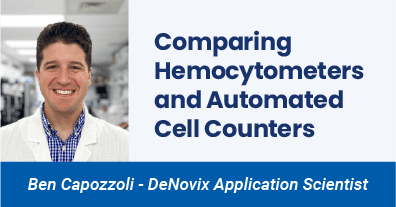Written by Ben Capozzoli, DeNovix Application Scientist
Since the invention of the hemocytometer counting chamber in 1874, biologists have been quantifying cells dispensed into the chamber of the slide through manual inspection under a microscope. These quantifications rely on knowing the exact volume in which you are counting. The following equation is used to translate cell counts in a given surface area / volume to cells/mL concentrations when counting cells using a hemocytometer:

Automated image-based cell counters utilize the same principle to quantify cells in a known volume over the camera. The major benefit of such a system is the speed and reproducibility with which they can provide an answer. For instance, a brightfield and two channel fluorescent count on the DeNovix CellDrop Automated Cell Counter takes no more than 10 seconds for most samples. Hand counting most samples and properly calculating the concentration takes several minutes.
Challenges of Manual Cell Counting
Manually counting living cells in a sample requires experience to distinguish between cell types, debris and red blood cells. It is not difficult to imagine that every member of the laboratory could potentially interpret the same sample differently, leading to varying cell concentrations from the sample image. On the other hand, automated cell counters utilize an algorithm with rules about how cells are characterized, so the count will not change from user to user.
Hemocytometers rely on a colorimetric stain called Trypan Blue to assess cell viability. Trypan Blue works by entering dead cells with compromised membranes and staining them dark blue. This dye falls short in distinguishing red blood cells or other debris which are easily mistaken for live cells from the actual cells of interest. This can lead to overestimation of viable cells in the suspension, potentially skewing accurate counts of viable cells.
Why Automated Cell Counting Improves Accuracy and Efficiency
As an alternative to hemocytometers, modern cell counters—automated image-based cell counters—overcome these issues. These systems use advanced imaging and software algorithms to analyze cell counts and viability in seconds. Unlike manual methods, automated counters:
- Standardize cell counting measurements.
- Eliminate inconsistencies by applying uniform rules for identifying the number of cells in a sample.
- Provide accurate counts without user bias.
Additionally, fluorescence-based viability staining provides a more reliable alternative to Trypan Blue staining, as it selectively labels only nucleated living cells, improving the precision of cell count and viability assessments.
Automated cell counters like the CellDrop can utilize a pair of fluorescent viability stains called Acridine Orange and Propidium Iodide (AO/PI). The combination of these fluorescent stains specifically identifies live and dead cells based upon the presence of a nucleus, since the dyes bind only with DNA. The stains will not interact with red blood cells or debris which are not nucleated, removing subjectivity and leading to increased precision. For more information on comparing trypan blue to AO/PI, see this technical note.
Taken together, image-based automated cell counters require less training and expertise to operate while offering a precision improvement across the entire lab’s cell counts. The counts can also happen in a fraction of the time needed to manually count a similar sample. The entire process is further improved through the utilization of a fluorescent viability stain. Ultimately, the quantification method that has been in place for 150 years is still applicable on automated cell counters, it is just made more efficient through modern computational techniques.
Final Thoughts
For laboratories looking to improve the accuracy and efficiency of cell culture workflows, automated cell counters provide a superior alternative to traditional counting chambers. By eliminating user variability, incorporating fluorescence-based staining, and reducing counting time, these devices ensure precise cell concentration measurements in cells/mL with minimal effort.
Want to learn more about the CellDrop Automated Cell Counter? Speak to a DeNovix application scientist!

Ben Capozzoli
DeNovix Application Scientist
Ben Capozzoli joined DeNovix in 2019 after receiving his Master’s degree in Immunology from Villanova University. He contributes to DeNovix product development and application support with expertise in spectrophotometry, immunology, imaging, cell biology, cell counting, and nuclei isolations. Outside of the lab, Ben enjoys cycling and playing music.
Speak to a DeNovix Scientist
Have an application question, or want to learn more about our products? Click the button below to schedule a call with our team of expert application scientists!



